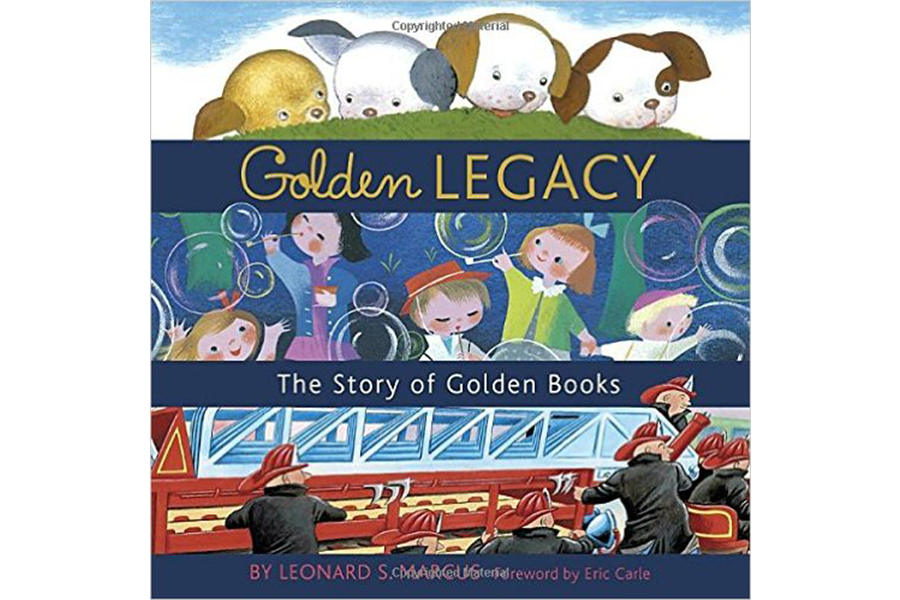'Golden Legacy' celebrates the literary triumph of the Golden Books
Look back far enough in the life of virtually any American reader – or writer – alive today, and you're very likely to find the same small library of books, brightly-colored little things full of lively action and clear, simple printing, creased and battered from endless re-readings. They're in every children's library in every city and small town in the country, and since 1942 they've been the training wheels of precocious American literacy.
They are of course the Little Golden Books, and in telling the vivid tale of their origins, a gloriously-illustrated new book, Golden Legacy: The Story of Golden Books (published by Golden Books, naturally) becomes an instant classic for the millions of adults who owe these little books a debt they can never fully repay.
Leonard Marcus, author of the excellent 2012 book "Tell Me a Story!: Why Picture Books Matter" here takes readers through the Golden Books story right from the beginning, when fledgling publisher Simon and Schuster teamed up with Western Printing and Lithographing Company in Racine, Wisconsin – specifically, with its “vaguely medieval-sounding” Artists and Writers Guild division – to produce a series of short, engaging books for very little children, produced with scrupulous attention to detail and, crucially, sold for a fraction the price of most children's books on the market in the early 1940s.
The man in charge of that initial idea was “an urbane European polymath” named Georges Duplaix, but Marcus's story is hardly a dozen pages old before his readers become increasingly aware of a perhaps unsurprising fact: The Golden Books story is mostly the story of strong-willed and visionary women who invariably knew far better than their male colleagues what would appeal to the mothers and young children who comprised their audience.
We meet Duplaix's indomitable second-in-command, Lucille Ogle: “A short, stocky woman with a booming stage voice, a helmet of prematurely white hair, and a gregarious, welcoming manner, Ogle had learned early how to hold her own in a man's world.” We meet editor Dorothy Bennett, second-in-command of Golden's sister publisher, Sandpiper Press: “a complex woman, she could be simultaneously generous and churlish, as when, responding to a poorly written unsolicited manuscript, she sent the hapless writer a dictionary by return mail, along with a rejection letter.”
We meet young Racine transfer Jane Werner, who came to the New York office in 1942 and noticed that her assigned desk had no typewriter. “When she mentioned this to [editor George] Wolfson, he advised the newcomer to keep the fact to herself; otherwise, as he predicted in what turned out to be one of the major understatements of her career, 'They'll expect you to use it.'” (She went on to write over a hundred Little Golden Books). We meet an early Golden Book ally, “the dynamic young editorial director of Harper and Brothers” Ursula Nordstrom: “[She] herself reveled in publishing books that poked holes in the library world's stuffy assumptions.” ("Dear Genius," Marcus's 1998 collection of Nordstrom's letters, is an unmissable, luminous joy of a book).
Golden quickly amassed an impressive roster of artists, including Feodor Rojankovsky, Gustaf Tenggren, and Richard Scarry, but here, too, the women in Marcus's story consistently out-shine the men: Dorothy Kunhardt's "Pat the Bunny" was the best-selling children's book of its season; Margaret Wise Brown, already well-known for "The Runaway Bunny," bought a gaudy Chrysler convertible with the advance she got from "The Golden Egg Book" “just to prove to herself that the check was real”; flinty, funny San Antonio author Janette Sebring Lowrey got a flat $75 for "The Poky Little Puppy," which went on to become the best-selling picture book of all time.
And as Marcus relates, much of the opposition the Golden Books faced also came from women: the nation's children's-desk librarians were at first adamant that books so inexpensive couldn't be good – and when their disapproval did nothing to stop runaway Golden Book sales, they were incensed. “The librarian-critics, who prided themselves on being cultural gatekeepers and moral guardians of the nation's youth, suddenly realized, much to their dismay, that in the case of Little Golden Books, they had been factored out of the equation,” Marcus writes. “No wonder their anger was palpable.”
They came around eventually, and those runaway sales have rolled right on to the present day. Little Golden Books continue to be a mainstay in every retail children's section in the country, where completely-unchanged titles from half a century ago like "The Night Before Christmas" and "Baby Farm Animals" sit next to Golden adaptations of "Finding Dory" and "Moana." The children who enjoyed those older classics are now the parents and grandparents of the kids discovering them for the first time in 2017, and for those parents and grandparents, Leonard Marcus has crafted the ultimate loving tribute to the men and women who were the architects of so much simple childhood joy, the “life-enhancing connection” that Little Golden Books have done so much to encourage.







